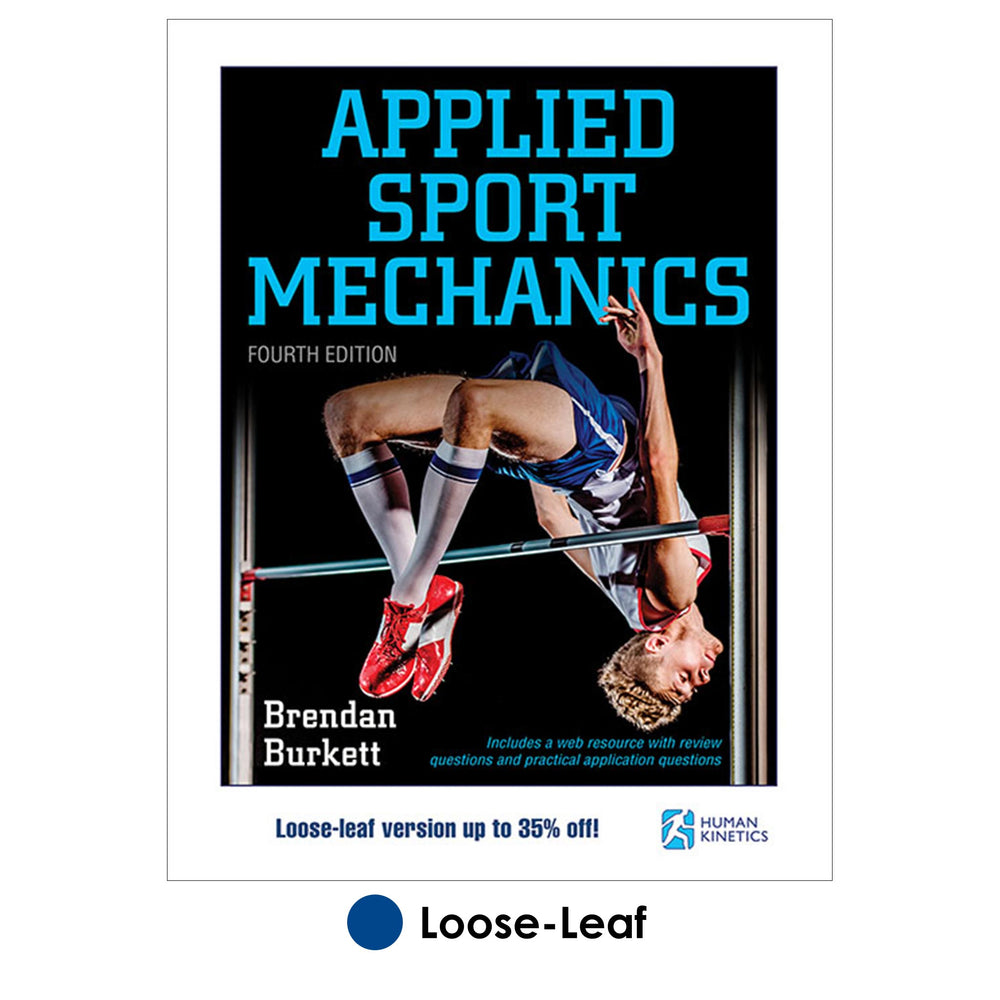Applied Sport Mechanics 4th Edition With Web Resource-Loose-Leaf Edition
Author: Brendan Burkett
$49.00 CAD
This is the loose-leaf version of Applied Sport Mechanics, Fourth Edition, which offers students a printed version of the text at a lower price.
Applied Sport Mechanics, Fourth Edition With Web Study Guide, helps undergraduate students understand how the fundamental laws of human movement affect athletes’ performances. Foundational principles of kinetics, kinematics, and sports technique are clearly presented and then explored through a variety of applied scenarios.
What’s New
This latest edition builds on the success of the previous editions (formerly titled Sport Mechanics for Coaches), and offers much new material:
• A web study guide with new chapter review questions and practical activities that help students learn and apply complex theories to real-life situations
• An array of updated pedagogical aids, including a glossary and chapter objectives to reinforce learning
• A full-color design for more engaging visual aids
• Reorganized content into two parts and 13 chapters to more readily fit the topics into a typical semester course structure
• Expanded sidebars that apply concepts directly to sport
To make the text applicable for teaching, it also includes a full ancillary package including an instructor guide with a sample syllabus, suggested learning activities, and lecture aids; a test package approximately 20 questions per chapter; and a presentation package plus image bank with ready-made presentations that instructors can use as is or modify to suit their needs.
Content Organization
Part I, which houses the first 10 chapters or 10 weeks, focuses on the fundamentals of sport mechanics. Major topics covered include the anatomy and fundamentals of sport mechanics, linear motion and linear kinetics in sport, angular motion and angular kinetics in sport, stability and instability, sport kinetics, and moving through fluids.
Part II, which contains the final three chapters, helps students apply the information they learned in part I. Chapters 11 and 12 explain how to observe and analyze an athlete’s technique and how to correct errors. Students learn how to break a skill into phases and what to look for in each phase. They also learn the mechanical principles that will help them correct the errors. Chapter 13 explores mechanics in a range of sport skills and techniques, including sprinting, jumping, swimming, lifting, throwing, and kicking. Students learn that technique and mechanics are inseparable.
The chapters also contain two helpful types of sidebars: At a Glance sidebars summarize difficult content with bulleted lists, and Application to Sport sidebars bring concepts to life, showing how they work in sport.
Go-To Resource
This fourth edition of Applied Sport Mechanics is a highly practical text, destined to be the go-to biomechanics and sport mechanics resource for instructors and professionals alike in kinesiology and sport related fields.
Audience
An introductory textbook for undergraduate courses in biomechanics and sport mechanics in kinesiology curriculums. Also a reference for coaches and physical educators.
Part I. Foundations of Movement in Sports
Chapter 1. Introduction to Applied Sport Mechanics
How Applied Sport Mechanics Is Organized
What Is Sport Mechanics?
Understanding and Quantifying Technique
Summary
Key Terms
References
Chapter 2. Sport Mechanics Anatomy
Standard Anatomical Reference Terminology
Connection Between Human Anatomy and Sport Mechanics
Summary
Key Terms
References
Chapter 3. Sport Mechanics Fundamentals
How to Describe Human Motion
Applying Sport Mechanics to Resistance Training
Measurement and Evaluation in Sport Mechanics
Summary
Key Terms
References
Chapter 4. Linear Motion in Sport
Linear Motion Measures (Speed, Velocity, and Acceleration)
Linear Motion for Projectiles
Summary
Key Terms
References
Chapter 5. Linear Kinetics in Sport
Fundamental Principles of Linear Kinetics
Momentum and Impulse in Sport
How to Measure Linear Kinetics: Running Gait
Summary
Key Terms
References
Chapter 6. Angular Motion in Sport
Fundamental Principles of Angular Motion
Applied Angular Motion: How an Athlete Initiates Rotation
Summary
Key Terms
References
Chapter 7. Angular Kinetics in Sport
Gravity: Fundamental Principle of Angular Kinetics
Angular Momentum
Summary
Key Terms
References
Chapter 8. Stability and Instability
Fundamental Principles for Stability
Mechanical Principles for Stability
Factors That Increase Stability
How to Measure Center of Gravity and Line of Gravity for an Athlete
Summary
Key Terms
References
Chapter 9. Sport Kinetics
Work
Power
Energy
Rebound
Friction
Summary
Key Terms
References
Chapter 10. Moving Through Fluids
Fundamental Principles of Moving Through Fluids
Hydrostatic Pressure and Buoyancy
Drag and Lift
Factors That Influence Moving Through Air and Water
Summary
Key Terms
References
Part II. Putting Your Knowledge of Sport Mechanics to Work
Chapter 11. Analyzing Sport Skills
Step 1: Determine the Objectives of the Skill
Step 2: Note Any Special Characteristics of the Skill
Step 3: Study Top-Flight Performances of the Skill
Step 4: Divide the Skill Into Phases
Step 5: Divide Each Phase Into Key Objectives
Step 6: Understand the Mechanical Reasons Each Key Element Is Performed as It Is
Summary
Key Terms
References
Chapter 12. Identifying and Correcting Errors in Sport Skills
Step 1: Observe the Complete Skill
Step 2: Analyze Each Phase and Its Key Elements
Step 3: Use Your Knowledge of Sport Mechanics in Your Analysis
Step 4: Select Errors to Be Corrected
Step 5: Decide on Appropriate Methods for the Correction of Errors
Summary
Key Terms
References
Chapter 13. Selected Sport Skills
Sprinting
Jumping
Wheelchair Sports
Throwing
Striking and Batting
Swinging and Rotating
Weightlifting
Combat Throwing
Tackle in Football
Swimming
Kicking a Ball
Paddling a Watercraft
References
Appendix. Units of Measurement and Conversions
Making use of angular momentum
Understand the mechanical reasons for each key element
Instructor guide. Includes a sample syllabus, suggested learning activities, and lecture aids.
Test package. Includes approximately 20 questions per chapter.
Presentation package plus image bank. Includes ready-made presentations highlighting material from the text that instructors can use for class discussion and demonstration. Plus, the image bank includes art and tables from the text, sorted by chapter, which can be used to develop a customized presentation based on specific course requirements.
Web resource. Includes new chapter review questions and practical activities that help students learn and apply complex theories to real-life situations.





